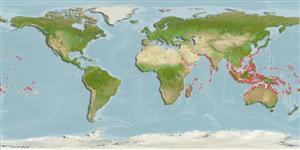Common names from other countries
Environment: milieu / climate zone / depth range / distribution range
Οικολογία
Υφαλόφιλο(α). Tropical; 30°N - 34°S, 27°E - 135°W (Ref. 846)
Indo-Pacific: Red Sea and East Africa to French Polynesia, North to Ryukyu, south to Australia.
Length at first maturity / Μέγεθος / Βάρος / Age
Maturity: Lm ? range ? - ? cm
Shallow reef environments especially reef margins exposed to strong wave action (Ref. 846), shallow reef tops and edges (Ref. 86439).
Life cycle and mating behavior
Γεννητική Ωρίμανση | Αναπαραγωγή | Γεννοβολία | Αβγά | Γονιμότητα | Προνύμφες
Members of the class Anthozoa are either gonochoric or hermaphroditic. Mature gametes are shed into the coelenteron and spawned through the mouth. Life cycle: The zygote develops into a planktonic planula larva. Metamorphosis begins with early morphogenesis of tentacles, septa and pharynx before larval settlement on the aboral end.
Wallace, C.C. 1999. (Ref. 86439)
IUCN Red List Status (Ref. 130435)
CITES status (Ref. 108899)
Not Evaluated
Threat to humans
Harmless
Human uses
| FishSource |
Εργαλεία
Περισσότερες πληροφορίες
Age/SizeΑύξησηLength-weightLength-lengthΜορφολογίαΠρονύμφεςΑφθονία
Διαδικτυακές πηγές
Estimates based on models
Preferred temperature
(Ref.
115969): 24.8 - 29.3, mean 28.3 (based on 2322 cells).
Price category
Unknown.
